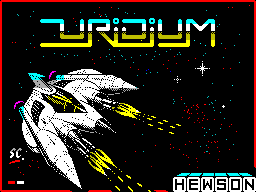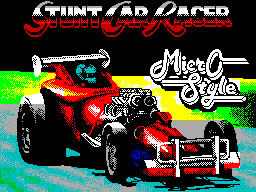Brian Bloodaxe was released for the ZX Spectrum early in 1985 by The Edge who had already gained success with games such as Starbike and Psytraxx.
Brian Bloodaxe is a notable ZX Spectrum classic game due to it's back story and off-beat humour.

Anyway, the whole story of this platform game was that he had been frozen in an ice block for hundreds of years - sounds like the big freeze of 2009! Anyway, being that he was a Viking king, he decides to continue where he left off: conquering Great Britain!
The game had around 100 screens of platform action to play through - and to win you had to steal the crown jewels and get our Brian seated on the throne.
In usual platform style you could move left and right and jump, allowing our 'hero' to move around the screens by jumping over enemies, gaps in the floor and so on.
Although Brian had to evade most of the games surreal and bizarre enemies (such as the famous Daleks from Doctor Who!), it was possible to kill some of them by headbutting - which would stab them with the horns of his helmet.
There were also a few items to collect which would help you in your quest (such as keys and tankards of beer) - but the emphasis of this platform game was on evading the nasties and exploration. On load up you knew you were in for something a little different. The 'liberty bell march' was the title tune and as you started the game - well let's say the first time I ever played Brian Bloodaxe it fooled me for a second. I never 'blew' on the keyboard though.... honest!
On load up you knew you were in for something a little different. The 'liberty bell march' was the title tune and as you started the game - well let's say the first time I ever played Brian Bloodaxe it fooled me for a second. I never 'blew' on the keyboard though.... honest!
This game is probably not as well remembered as other platform or arcade games on the ZX Spectrum, but it was pretty well received when it came out. Other platformers such as Manic Miner, Technician Ted, Dynamite Dan and Jet Set Willy became the kings of the genre - Brian Bloodaxe is more of a cult title.
On Release:
Brian Bloodaxe was well recieved when it was released for the ZX Spectrum and many enjoyed the slightly wacky humour within the game. Unfortunately it came out in the midst of other platform games, and it lacked the overall polish of a lot of these other titles. It was a decent enough game at the time and for anyone that was into platform games it was definately worth getting hold of.
The test of time:
Me and my fellow geek reckon that in the grand scheme of Spectrum Games Brian Bloodaxe has not aged at all well. The graphics are pretty basic and overall the game does lack a bit of polish. Mind you, it did make us laugh - the opening of it is still funny. Worth a look for nostalgia and for anyone that missed it first time around.
It should be noted that this game is currently being remade (it must have a cult following) - check out http://mremakes.free.fr/ for more information.
We recommend getting hold of the real hardware but if not then download a ZX Spectrum emulator and download Brian Bloodaxe for the ZX Spectrum. Alternatively you could try and play it online.
GENRE: Platform game (Arcade Game)
RELEASE DATE: Early 1985
RELEASED BY: The Edge
DEVELOPER(S): Charles Bystram
PRICE: £7.95 - UK
The humourus opening to a lesser known yet classic game:
Arcade Games, Classic Games and ZX Spectrum Games

















 You are a programming genious
You are a programming genious














